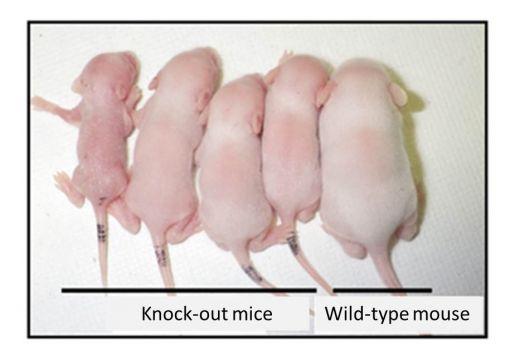Research News
The Silence of the Genes—New Insights into Genomic Imprinting
Research led by Dr. Keiji Tanimoto from the University of Tsukuba, Japan, has brought us closer to understanding the mechanisms underlying the phenomenon of genomic imprinting. In this intriguing event, one copy of a gene is 'turned off', or silenced, depending on whether it was derived from the mother or the father. The research team has identified a segment of DNA that is essential in the imprinting process for the closely linked Igf2/H19 genes, two of the first imprinted genes to be discovered. If these genes are incorrectly imprinted, it can lead to the overgrowth (Beckwith?Wiedemann) or dwarfism (Silver Russell) syndromes, and also has a role in some kidney and liver cancers.
We each inherit two copies of every gene ? one from our mother and one from our father. For most genes, both copies are active and working. In a small number of genes, however, one copy is turned off depending on its parental origin. These genes are termed imprinted because the one copy was tagged or imprinted via modifications to the DNA in either the egg or the sperm. The mechanisms for imprinting are not fully understood, but they involve modifications to the DNA that are removed and then reset 'de novo' during the creation of eggs and sperm. These modifications are termed epigenetic modifications, as the DNA sequence itself is not altered.
Normally we only have one copy of a silenced gene. If an error occurs in the imprinting process, we might end up with two active copies of the gene or two inactive or silenced copies. This can lead to abnormal development, behavioral disorders, cancer and various disease syndromes, such as the behavioral and neurodevelopmental disorders Prader?Willi and Angelman syndromes. Imprinting disorders have also been linked to diabetes, for example.
As reported in the latest volume of the prestigious journal Development, the team of scientists from the University of Tsukuba, the Nagahama Institute of Bio-Science and Technology, Osaka University and the National Research Institute for Child Health and Development, investigated when and how the imprintedIgf2/H19 genes in mouse are modified during early development in order to further understand the mechanisms underlying the imprinting process. The Igf2/H19 genes in mouse are two of the best characterized imprinted genes and the same imprinting pattern has been found in their human equivalents, making them ideal candidates for further research.
Imprinted genes are controlled by nearby DNA sequences, so-called imprinting control regions (ICRs), which have parental-specific modifications, including DNA methylation. Methylation is a chemical reaction that attaches small molecules called methyl groups to certain segments of DNA. In genes that undergo genomic imprinting, methylation is one way that a gene's parent of origin is marked during the formation of egg and sperm cells. ICRs are methylated by proteins called DNA methyltransferases (DMTs) during egg and sperm development. This methylation is faithfully maintained at the imprinted gene throughout development, even in early embryos where genomes undergo extensive reprogramming, including removal of methylation from the DNA. The H19 ICR in the mouse is DNA-methylated by two DMTs, Dnmt3a and Dnmt3L, during sperm formation. This methylation is maintained on the paternally-derived copy of the Igf2/H19 genes following fertilization, rendering these genes 'imprinted'. The research team were interested to discover when and how this methylation is so faithfully maintained.
Using an elegant genetic strategy involving the cross-breeding of several strains of transgenic mice, the team found that paternal-specific methylation of the H19 ICR commences soon after fertilization and that the maternally-supplied DNA methyltransferases Dnmt3a and Dnmt3L are required for this process. This is the first example demonstrating a role for Dnmt3L during early embryogenesis.
Even when the methylation of the mouse H19 ICR was partially obstructed in the sperm, the paternalH19 ICR also exhibited postfertilization methylation. It therefore seems likely that the H19 ICR acquired an unknown epigenetic mark or tag, other than DNA methylation, during sperm formation, and after fertilization the de novo DNA methylation machinery recognized this mark. Possible candidates for the epigenetic marks acquired during sperm formation are modifications or variants in histones, the proteins around which DNA is wrapped.
The team were then able to narrow down the sequence within the ICR responsible for this postfertilization acquisition of methylation to a sequence located right at the beginning of the ICR, the so-called 5'-region. Deletion of this 5'-region from the mouse H19 ICR results in a partial loss of methylation on the paternal copy of the gene, abnormal expression of H19 and its neighboring imprinted gene, Igf2 and growth retardation. This is the first example of a regulatory DNA sequence that is able to regulate the methylation of the paternal H19 ICR, as all other regulatory sequences to date function to maintain the unmethylated state of the maternal H19 ICR, postimplantation.
Dr Tanimoto concludes that 'these results demonstrate that this segment of the H19 ICR is essential for its de novo post-fertilization DNA methylation, and that this activity contributes to the maintenance of imprinted methylation at the H19 ICR during early embryogenesis'.
One of the next steps is to find the primary mark that instructs imprinted DNA methylation in early embryos in the genes responsible for imprinting disorders in humans. This knowledge may have therapeutic benefits in future, by allowing us, for example, to induce the re-expression of the silent parental gene copies in patients in order to improve their symptoms.
Original Paper
Hitomi Matsuzaki, Eiichi Okamura, Takuya Takahashi, Aki Ushiki, Toshinobu Nakamura, Toru Nakano, Kenichiro Hata, Akiyoshi Fukamizu, Keiji Tanimoto De novo DNA methylation through the 5′-segment of the H19 ICR maintains its imprint during early embryogenesis, Development, 142(22),
DOI: 10.1242/dev.126003(2015)



